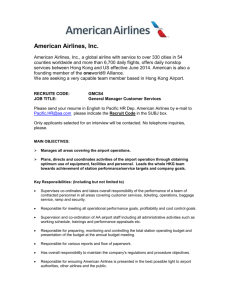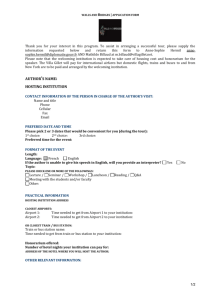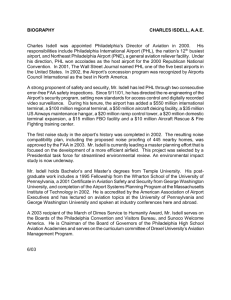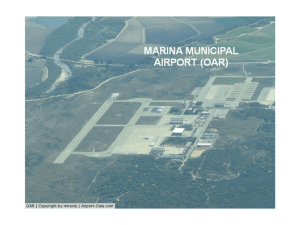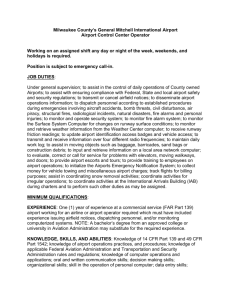Flexibility is the key to airport strategic planning
advertisement
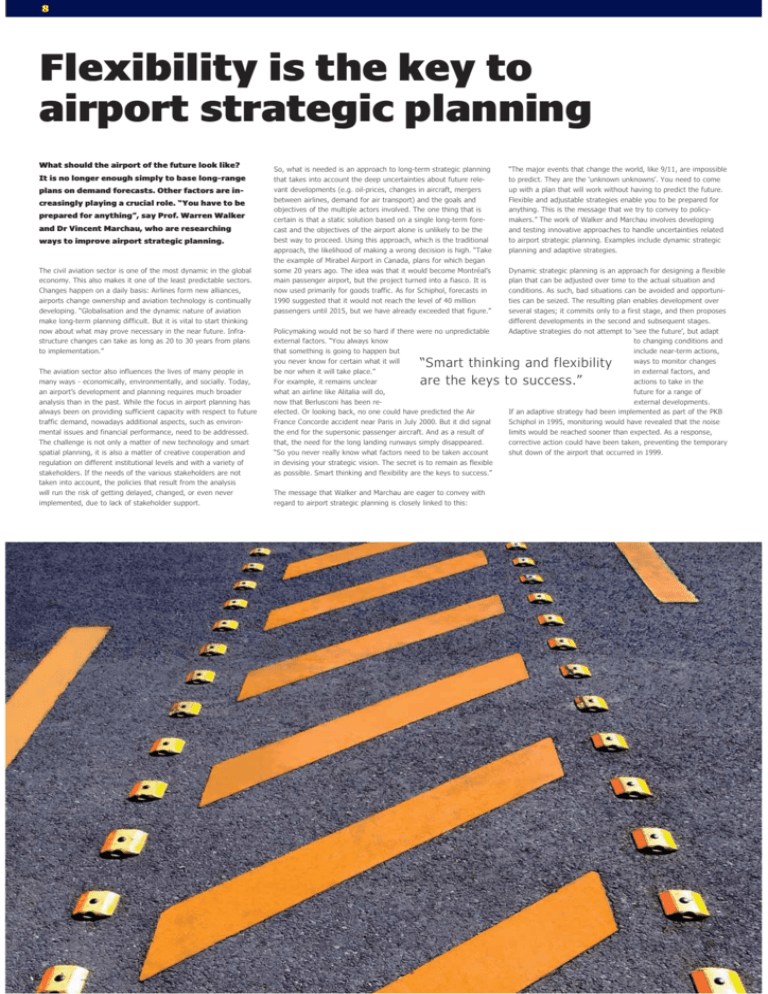
8 Flexibility is the key to airport strategic planning What should the airport of the future look like? It is no longer enough simply to base long-range plans on demand forecasts. Other factors are increasingly playing a crucial role. “You have to be prepared for anything”, say Prof. Warren Walker So, what is needed is an approach to long-term strategic planning “The major events that change the world, like 9/11, are impossible that takes into account the deep uncertainties about future relevant developments (e.g. oil-prices, changes in aircraft, mergers to predict. They are the ‘unknown unknowns’. You need to come up with a plan that will work without having to predict the future. between airlines, demand for air transport) and the goals and objectives of the multiple actors involved. The one thing that is Flexible and adjustable strategies enable you to be prepared for anything. This is the message that we try to convey to policy- certain is that a static solution based on a single long-term fore- makers.” The work of Walker and Marchau involves developing cast and the objectives of the airport alone is unlikely to be the best way to proceed. Using this approach, which is the traditional and testing innovative approaches to handle uncertainties related to airport strategic planning. Examples include dynamic strategic approach, the likelihood of making a wrong decision is high. “Take planning and adaptive strategies. The civil aviation sector is one of the most dynamic in the global the example of Mirabel Airport in Canada, plans for which began some 20 years ago. The idea was that it would become Montréal’s Dynamic strategic planning is an approach for designing a flexible economy. This also makes it one of the least predictable sectors. Changes happen on a daily basis: Airlines form new alliances, main passenger airport, but the project turned into a fiasco. It is now used primarily for goods traffic. As for Schiphol, forecasts in plan that can be adjusted over time to the actual situation and conditions. As such, bad situations can be avoided and opportuni- airports change ownership and aviation technology is continually 1990 suggested that it would not reach the level of 40 million ties can be seized. The resulting plan enables development over developing. “Globalisation and the dynamic nature of aviation make long-term planning difficult. But it is vital to start thinking passengers until 2015, but we have already exceeded that figure.” several stages; it commits only to a first stage, and then proposes different developments in the second and subsequent stages. now about what may prove necessary in the near future. Infra- Policymaking would not be so hard if there were no unpredictable Adaptive strategies do not attempt to ‘see the future’, but adapt structure changes can take as long as 20 to 30 years from plans to implementation.” always been on providing sufficient capacity with respect to future traffic demand, nowadays additional aspects, such as environ- external factors. “You always know that something is going to happen but you never know for certain what it will be nor when it will take place.” For example, it remains unclear what an airline like Alitalia will do, now that Berlusconi has been reelected. Or looking back, no one could have predicted the Air France Concorde accident near Paris in July 2000. But it did signal If an adaptive strategy had been implemented as part of the PKB Schiphol in 1995, monitoring would have revealed that the noise mental issues and financial performance, need to be addressed. the end for the supersonic passenger aircraft. And as a result of limits would be reached sooner than expected. As a response, The challenge is not only a matter of new technology and smart spatial planning, it is also a matter of creative cooperation and that, the need for the long landing runways simply disappeared. “So you never really know what factors need to be taken account corrective action could have been taken, preventing the temporary shut down of the airport that occurred in 1999. regulation on different institutional levels and with a variety of in devising your strategic vision. The secret is to remain as flexible stakeholders. If the needs of the various stakeholders are not taken into account, the policies that result from the analysis as possible. Smart thinking and flexibility are the keys to success.” will run the risk of getting delayed, changed, or even never implemented, due to lack of stakeholder support. The message that Walker and Marchau are eager to convey with regard to airport strategic planning is closely linked to this: and Dr Vincent Marchau, who are researching ways to improve airport strategic planning. The aviation sector also influences the lives of many people in many ways - economically, environmentally, and socially. Today, an airport’s development and planning requires much broader analysis than in the past. While the focus in airport planning has “Smart thinking and flexibility are the keys to success.” to changing conditions and include near-term actions, ways to monitor changes in external factors, and actions to take in the future for a range of external developments.
